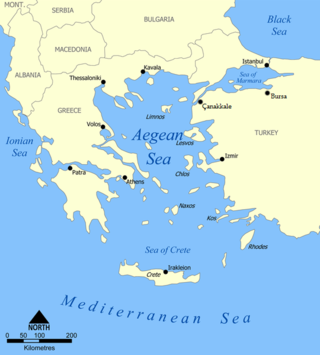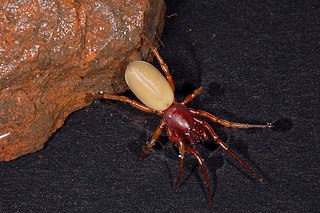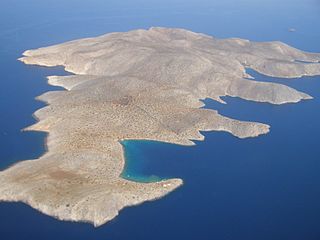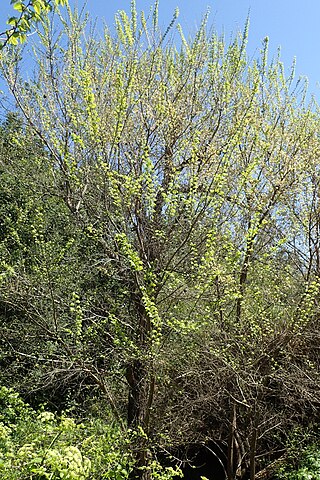
The Aegean Sea is an elongated embayment of the Mediterranean Sea between Europe and Asia. It is located between the Balkans and Anatolia, and covers an area of some 215,000 km2 (83,000 sq mi). In the north, the Aegean is connected to the Marmara Sea, which in turn connects to the Black Sea, by the straits of the Dardanelles and the Bosphorus, respectively. The Aegean Islands are located within the sea and some bound it on its southern periphery, including Crete and Rhodes. The sea reaches a maximum depth of 3,544 m (11,627 ft) to the east of Crete. The Thracian Sea and the Sea of Crete are main subdivisions of the Aegean Sea.

Crete is the largest and most populous of the Greek islands, the 88th largest island in the world and the fifth largest island in the Mediterranean Sea, after Sicily, Sardinia, Cyprus, and Corsica. Crete is located about 100 km (62 mi) south of the Peloponnese, and about 300 km (190 mi) southwest of Anatolia. Crete has an area of 8,450 km2 (3,260 sq mi) and a coastline of 1,046 km (650 mi). It bounds the southern border of the Aegean Sea, with the Sea of Crete to the north and the Libyan Sea to the south. Crete covers 260 km from west to east but is narrow from north to south, spanning three longitudes but only half a latitude.

In Greek mythology, the Minotaur, also known as Asterion, is a mythical creature portrayed during classical antiquity with the head and tail of a bull and the body of a man or, as described by Roman poet Ovid, a being "part man and part bull". He dwelt at the center of the Labyrinth, which was an elaborate maze-like construction designed by the architect Daedalus and his son Icarus, upon command of King Minos of Crete. According to tradition, every nine years the people of Athens were compelled by King Minos to choose fourteen young noble citizens to be offered as sacrificial victims to the Minotaur in retribution for the death of Minos's son Androgeos. The Minotaur was eventually slain by the Athenian hero Theseus, who managed to navigate the labyrinth with the help of a thread offered to him by the King's daughter, Ariadne.

The Minoan civilization was a Bronze Age culture which was centered on the island of Crete. Known for its monumental architecture and energetic art, it is often regarded as the first civilization in Europe. The ruins of the Minoan palaces at Knossos and Phaistos are popular tourist attractions.

The Battle of Crete, codenamed Operation Mercury, was a major Axis airborne and amphibious operation during World War II to capture the island of Crete. It began on the morning of 20 May 1941, with multiple German airborne landings on Crete. Greek and other Allied forces, along with Cretan civilians, defended the island. After only one day of fighting, the Germans had suffered heavy casualties and the Allied troops were confident that they would defeat the invasion. The next day, through communication failures, Allied tactical hesitation, and German offensive operations, Maleme Airfield in western Crete fell, enabling the Germans to land reinforcements and overwhelm the defensive positions on the north of the island. Allied forces withdrew to the south coast. More than half were evacuated by the British Royal Navy and the remainder surrendered or joined the Cretan resistance. The defence of Crete evolved into a costly naval engagement; by the end of the campaign the Royal Navy's eastern Mediterranean strength had been reduced to only two battleships and three cruisers.

The history of Crete goes back to the 7th millennium BC, preceding the ancient Minoan civilization by more than four millennia. The Minoan civilization was the first civilization in Europe.

Dysderidae, also known as woodlouse hunters, sowbug-eating spiders, and cell spiders, is a family of araneomorph spiders first described by Carl Ludwig Koch in 1837. They are found primarily in Eurasia, extending into North Africa with very few species occurring in South America. Dysdera crocata is introduced into many regions of the world.

Dia, also pronounced locally Ntia, is an uninhabited island off the northern coast of the Greek island of Crete. The island is 5 km long, 3 km wide and is located approximately 13 km north of Heraklion. Administratively, Dia is part of the community of Elia within the municipal unit of Gouves, Hersonissos municipality in Heraklion.

Sitia or Siteia is a port town and a municipality in Lasithi, Crete, Greece. The town has 11,166 inhabitants and the municipality has 20,438 (2021). It lies east of Agios Nikolaos and northeast of Ierapetra. Sitia's port is on the Sea of Crete, part of the Aegean Sea and is one of the economic centers of the Lasithi region. European route E75 starts in Sitia. The town is served by the Sitia Public Airport. It has not experienced the effects of mass tourism even though there is a long beach along the road leading to Vai and several places of historical interest.

Chania, also spelled Hania, is one of the four regional units of Crete; it covers the westernmost quarter of the island. Its capital is the city of Chania. Chania borders only one other regional unit: that of Rethymno to the east. The western part of Crete is bounded to the north by the Cretan Sea and to the west and south by the Mediterranean Sea and Libyan Sea. The regional unit also includes the southernmost island of Europe, Gavdos.

Mount Ida, known variously as Idha, Ídhi, Idi, and Ita, is the highest mountain on the island of Crete, with an elevation of 2,456 metres (8,058 ft). It has the highest topographic prominence of any mountain in Greece. A natural park which includes Mount Ida is a member of UNESCO's Global Geoparks Network.

Ulmus minorsubsp.canescens is a small deciduous tree occasionally known by the common names grey elm, grey-leafed elm, and hoary elm. Its natural range extends through the lands of the central and eastern Mediterranean, from southern Italy, the islands of Sicily, Malta, Crete, Rhodes and Cyprus, and through Thrace to Turkey, and as far south as Israel, where it is now considered rare and endangered in the wild. The tree is typically found amidst the comparatively humid coastal woodlands and scrublands.

Candiacervus is an extinct genus of deer native to Pleistocene Crete. Due to a lack of other herbivores, the genus underwent an adaptive radiation, filling niches occupied by other taxa on the mainland. Due to the small size of Crete, some species underwent insular dwarfism, the smallest species, C. ropalophorus, stood about 40 centimetres (16 in) at the shoulders when fully grown, while other species were relatively large and comparable in size to mainland deer species. Some species are noted for their peculiar, elongate club-shaped antlers, though other species have more normal antlers.

Scilla section Chionodoxa, known as glory-of-the-snow, is a small group of bulbous perennial flowering plants in the family Asparagaceae, subfamily Scilloideae. Formerly treated as the separate genus Chionodoxa, they are now included in Scilla as a section. The section is endemic to the eastern Mediterranean, specifically Crete, Cyprus and Turkey. The blue, white or pink flowers appear early in the year making them valuable garden ornamentals. The common name of the group is based on the habit of flowering in high alpine zones when the snow melts in spring.

The Crete spiny mouse is a species of mouse endemic to Crete. It is characterized by the coarse, stiff hairs on its back and tail and a notably grayer coloration and more pointed face than other species of spiny mice. Its fur color varies from yellow to red, gray or brown on its face and back, with white fur on its underside. It is a nocturnal forager, feeding mainly on grass blades and seeds, and builds only a very rudimentary nest.

The Cretan shrew is a species of mammal in the family Soricidae. It is endemic to the island of Crete, Greece. Its natural habitat is temperate shrubland, and the animal is threatened by habitat loss. It is found in the mountainous highlands of Crete, having been displaced from lower altitudes by the lesser white-toothed shrew.

Prasonisi, also known as Vryonisi, is an uninhabited Greek islet, in the Aegean Sea, close to the northern coast of eastern Crete. It is extremely small, measuring just 0.034 square kilometres (370,000 sq ft) in area. Notably, there is a shipwreck on the islet's southern side, over thirty metres beneath the sea; the ship itself is broken up and possibly buried but remains of pottery, including amphorae, have been reported. Various species of sea snail have been recorded living on and around the island. The island itself is mostly covered by salt-tolerant plants.
Hanak's dwarf bat or Hanak's pipistrelle is a species of bat only found in Cyrenaica, Libya and Crete, Greece.

The Crete Mediterranean forests is a terrestrial ecoregion that encompasses the Greek island of Crete.

















